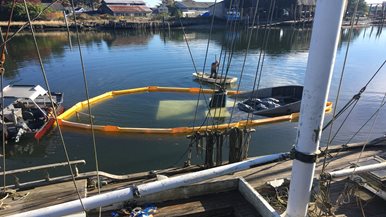Hoquiam River vessel sinkings and spills
This is the most current information about our response efforts at 220 Monroe St. in Hoquiam where sunken vessels have spilled oil into the Hoquiam River.
Summary information
220 Monroe Street, Hoquiam, Washington, Grays Harbor County.

View of one of the submerged vessels in the Hoquiam River in October 2018.
Status updates
See photos of the seven vessels that have sunk at this site since 2017 on our Flickr site.
February 1, 2019
On January 31, 2019, we issued the following enforcement actions to John Simons, Jr., owner of the fishing vessels, Perwyn and Lady Grace. Mr. Simons received a:
- $1,500 penalty for the Perwyn sinking and spill on July 26, 2017.
- $2,000 penalty for the Lady Grace sinking and spill on March 2, 2018.
- $29,022.85 bill to reimburse our expenses in responding to the Lady Grace.
Additionally, Simons received two resource damage assessments. A resource damage assessment may be an environmental restoration or enhancement project, or a payment into a fund that pays for such projects.
- $2,360.24 for the Perwin
- $10,116.65 for the Lady Grace
Dec. 27, 2018
Vessels sunken at this site that we have documented:
July 5, 2017 - Donna
July 26, 2017 - Perwyn
November 6, 2017 - Two Sisters
March 2, 2018 - Lady Grace
October 17, 2018 - Two vessels (names unknown)
December 25, 2018 - Former Navy patrol boat
December 26, 2018
We responded to an oil spill on Dec. 25 from another sunken vessel at 220 Monroe St. on the Hoquiam River after it was reported to us by the Hoquiam Police. When we arrived, we found a 30-foot fiberglass hull completely submerged. We collected samples, and with help from people associated with the private marina, placed absorbent pads to collect oil. We estimated the spill was about 10-15 gallons of motor (lube) oil. We observed shoreline impacts approximately 500 yards upstream and downstream from the incident site.
The city of Hoquiam has issued numerous code violations and has been working closely us, the Washington Office of Attorney General, and U.S. Coast Guard regarding the sunken vessels at this site and the concern over ongoing pollution exposure to the Hoquiam River.
This is now the seventh sunken vessel we’ve responded to at this location. The tidally influenced area is privately owned, limiting the state's ability to require the vessels be removed.
October 19, 2018
Today, divers assessed the feasibility of safely removing the fuel from the sunken vessels and found it to be unsafe because one of the vessels is laying upon the other, making it unsafe to access the fuel tanks.
The EPA, state Fish & Wildlife, and U.S. Fish & Wildlife observed no impacts from the spill at the Grays Harbor National Wildlife Refuge and found no dead fish or oiled wildlife. Cleanup contractors continued to work aggressively to contain and clean-up the spill.
October 18, 2018
Ecology, EPA, and Global Diving & Salvage were on-scene to continue the cleanup of the oil that has spilled into the river. Unified Command continues to work with the property owner to raise the vessels and remove the fuel aboard them.
Additional our responders, the Washington Department of Fish & Wildlife, and the Quinault Tribe continue to assess up and downstream impacts, conduct wildlife surveys, and collect water samples.
The property owner was unable to raise the vessels or remove fuel from them. Lab results indicated the vessels are releasing diesel to the Hoquiam River.
October 17, 2018
We were notified this morning that two vessels were sinking in the Hoquiam River near 220 Monroe Street and that there was an oil sheen in the river. The vessels were reportedly approximately 45 feet long, one with a concrete hull and the other with a wooden and fiberglass hull. This area is the same location where four vessels had previously sunk, the most recent was the Lady Grace in March of 2018, a vessel that is still laying on the river bottom, and partially exposed.
Our responders arrived at the scene in the early afternoon, and found that the property owner ineffectively placed oil containment boom around the sunken vessels. In coordination with our federal partner, the U.S. Environmental Protection Agency (EPA), we formed a Unified Command, and hired environmental cleanup contractor Global Diving & Salvage to place containment boom around the vessels and absorbent pads in the water. State Fish & Wildlife and additional responders helped assess up and downstream impacts, conducted wildlife surveys, and collected water samples.
It appeared that the two vessels were tied together and when one started sinking, it pulled the second into the water as well.
The property owner said he owns one of the vessels. Unified Command gave him one day to remove his vessel and the fuel from the water. The owner of the second vessel is unable to be reached despite multiple attempts to contact him.

